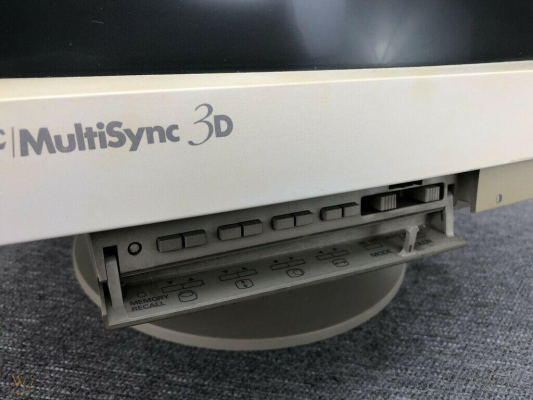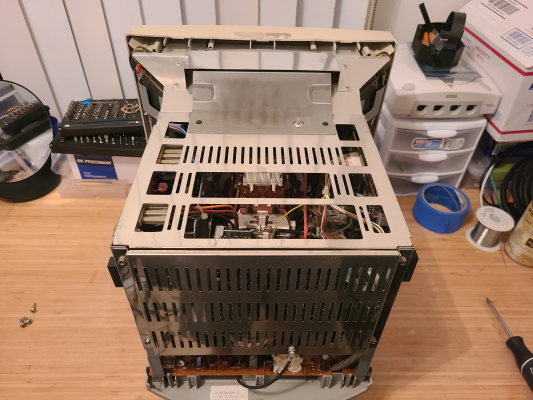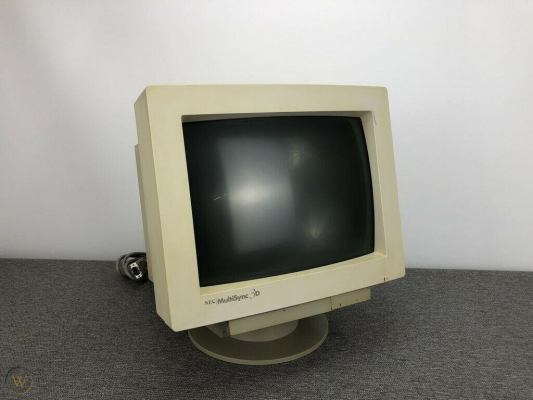Summary
Known as the "Multisync 3DS". Successor to the NEC Multisync 3D. It has the same model number with an added "-2" suffix" and the "3DS" branding on the front. The only difference between the 3DS and the 3D (besides minor design changes with the outer rear shell) is the internal magnetic shielding (see pictures below). NEC was under public pressure to make their monitors magnetically shielded during the "x-rays" scare of the early 1990s when consumers were concerned that CRT x-rays may cause cancer (note: they do not emit x-rays even without extra shielding). NEC simply re-released their popular Multisync 3D with additional internal metal shielding and denoted it with an "S" for shielded, creating the Multisync 3DS.
The 3D/3DS also have a key feature called "memory mode" which allows you a preset for H/V size/position. Useful for if you find yourself adjusting constantly switching between two sources.
The 3D/3DS use a more sophisticated digital processing to determine how to lock to the incoming sync signal - compared to the previous Multisync I and II which simply used a network of 555 timer gates to loosely categorize the scan rate to different preset ranges the monitor can handle.
Lastly instead of using a standard HD-15 VGA connector, the 3D/3DS use a DB15 connector. Same amount of pins but laid out in two rows instead of 3. You will need a passthrough DB15 to HD15 adapter to connect a VGA cable. It would also appear that NEC updated the later production runs to use HD15 connectors instead of DB15 - so you may get lucky and find one that doesn't need an adapter.
Manuals
Notes
Modeline
Section "Monitor" Identifier "NEC 3D" VendorName "NEC" ModelName "MultiSync 3D" Bandwidth 45.0 HorizSync 15.5-38.0 VertRefresh 50.0-90.0 ModeLine "640x480" 25 640 672 768 800 480 490 492 525 ModeLine "800x600" 36 800 824 896 1024 600 601 603 625 ModeLine "1024x768i" 46 1024 1064 1224 1264 768 777 785 817 interlace EndSection
Sync
For RGsB (Sync on Green), the monitor will accept sync from the green video signal at the standard of 0.3-0.6vpp. For all other cases (HV Sync, CSync), it needs TTL level to pin 4 (and 5 for V Sync) of the DB9 connector.
Horizontal Output Transistor (2SC3486) Notes
This horizontal output transformer is used across all four of the multisync NEC JC-140X models. I've had to deal with several ones which are dead, so I wanted to include some notes about how to tell if yours is dead.
A "probably good" 2SC3486 will have the following measurements from a multimeter in resistance mode:
- 340-370K with red probe on base and black probe on emitter
- "OL" out-of-range with red probe on emitter and black probe on collector. If you get a reading of 50M or less resistance, the internal diode is bad, regardless of what diode check shows you. This was consistent across all 4 dead 2SC3486's I've replaced.
A "probably good" 2SC3486 will have the following measurements from a multimeter in diode-check mode:
- beep/good with black probe on collector, red probe on base
- beep/good with black probe on emitter, red probe on base.
- all other combinations of the legs should not show any voltage reading or good beeps on the multimeter.
Be careful to make sure the paper guard behind the 2SC3486 remains in place when replacing one. If the back plate of the chip makes direct metal to metal contact with the heat sink its mounted to, it will arc and kill the chip when powered.
Gallery





 This work is licensed under a
This work is licensed under a